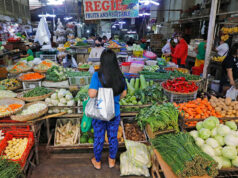Gov’t finds fewer Filipinos poor in 2018
FEWER FILIPINOS were mired in poverty in 2018, the Philippine Statistics Authority (PSA) reported on Friday.
The PSA’s full-year 2018 official poverty data placed poverty incidence among individuals — the proportion of Filipinos whose incomes fell below the poverty threshold — at 16.6%, compared to the revised 23.3% recorded in 2015.
The data were derived from the Family Income and Expenditure Surveys (FIES) which the PSA conducts every three years. The latest FIES 2018, which used a sample size of around 180,000 households, incorporated revisions for the 2015 full-year poverty figures due to the rebasing of the consumer price index market basket prices to 2012 from 2006 as well as the adoption of the 2015 census results for the weights in the FIES.
The latest poverty result translates to a reduction of around 5.9 million poor individuals to 17.6 million in 2018 compared to 23.5 million in 2015.
Likewise, poverty incidence among Filipino families — or the proportion of those whose incomes fell below the poverty threshold — went down to 12.1% from 17.9%.
The subsistence incidence among Filipinos — or the proportion of those whose incomes fell below the monthly food threshold — likewise went down to 5.2% in 2018 from 9.1% in 2015.
The subsistence incidence among families — or the proportion of those in extreme poverty — improved to 3.4% from 6.4%.
The food threshold is defined as the minimum income required to meet basic food needs and satisfy the nutritional requirements “for economically necessary and socially desirable physical activities.”
Similarly, the poverty threshold is defined as the minimum income needed to meet basic food and non-food requirements.
The per capita poverty threshold in 2018 was P2,145.36 per month as compared to P1,890.44 per month in 2015.
Meanwhile, the monthly poverty threshold for a family of five members was P10,726.79 versus P9,452.18 in 2015.
The per capita food threshold was P1,505.6 per month in 2018 as compared to P1,321.01 in 2015. For a family of five, the monthly food threshold in 2018 was P7,528.02 versus P6,605.07 in 2015.
On average, incomes of poor families were short by 21.8% of the poverty threshold in 2018, the PSA noted.
This means that, on average, an additional monthly income of P2,338 was needed by a poor family with five members in order to move out of poverty in 2018.
“With a poverty reduction rate of 2.23 percentage points per annum, we are not only on track to meet our [Philippine Development Plan 2017-2022] target of bringing down poverty incidence to 14% by 2022. We are also likely to meet the Sustainable Development Goal or SDG target of eradicating extreme poverty as defined by the international poverty line and cutting by half the proportion of the population living below the national poverty line by 2030,” said National Economic and Development Authority (NEDA) Officer-in-Charge Adoracion M. Navarro.
“In fact, we have almost reached our target to lift 6 million Filipinos out of poverty by 2022 as 5.9 million have already been lifted out of poverty as of 2018,” added Ms. Navarro, who is also NEDA’s undersecretary for Regional Development.
The NEDA official added that the reduction in poverty rates is “largely attributed” to “improved labor market conditions” that drove up the salaries and wages of the poor.
“With a vibrant economy that continues to generate good jobs, the mean salaries and wages for the population went up by 22.8% to P156,114 in 2018, from P127,122 in 2015. For those in the bottom 30% of the population, mean per capita income increased by 31.87%. This outpaced the 18% income growth experienced by the top 20% of households. This is a good sign that our programs targeting the poor are working well,” Ms. Navarro said.
Security Bank Corp. Chief Economist Robert Dan J. Roces said the latest poverty result “jives” with the recently-released data on unemployment and underemployment.
“Better job opportunities on the back of improved labor market conditions, better wages, and some form of relaxed taxation have contributed to better incomes for poor households. The latter, however, remains the most at-risk relative to sudden jumps in inflation especially in staples such as rice and other foodstuff,” Mr. Roces said in an e-mail.
“Additionally, most of the unbanked come from the poorer households and these have no access to formal financial services. Financial literacy and inclusion must be able to target them if we are to strive for a 14% poverty incidence target by 2022,” he added.
For Rizal Commercial Banking Corp. Economist Michael L. Ricafort, the latest poverty result “was a pleasant surprise.”
“The lower poverty incidence… may have been fundamentally brought about by improved economic conditions that are conducive in creating more jobs and business opportunities to more individuals… thereby resulting in increased incomes and spending power that led to greater growth in consumer spending which accounts for about 70% of the economy,” he said.
Asked for his outlook, Mr. Ricafort said that poverty incidence may continue to improve in the coming years amid the economy’s improved fundamentals as well as “improved demographics.”
“With more Filipinos already reaching working age, this fundamentally led to lower poverty incidence amid increased incomes, productivity, and spending in the population, thereby supporting increased economic activities, faster economic growth and higher per capita income,” he said.
However, he cited major risks to this outlook such as (1) delays in the passage of the national budget that would lead to government underspending on infrastructure projects, social services, and poverty reduction programs; and (2) the lingering US-China trade war as they disrupted local industries “that are part of exporters’ supply/value chains” thereby indirectly reducing employment. — Carmina Angelica V. Olano and Edwin C. Aruta, Jr.



